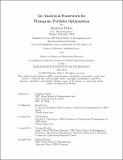An Analytical Framework for Planogram Portfolio Optimization
Author(s)
Habel, Mathew
DownloadThesis PDF (1.383Mb)
Advisor
Levi, Retsef
Farias, Vivek
Terms of use
Metadata
Show full item recordAbstract
While considerable research has been conducted into the construction of optimal planograms (POGs) within a given store, the existing approaches have not been rigorously tested at scale across a network chain of retail stores. Moreover, current industry practices to design planograms are often ad hoc and anecdotal, and lead to proliferation of many different planograms that add complexity but not necessarily value. This thesis proposes an analytical framework for an end-to-end optimization of portfolios of planograms within Target, focusing on the optimal trade-off between planogram-store personalization and standardization. The study utilizes retail data from Target to develop mathematical frameworks partly based on machine learning and optimization techniques to address the challenge of managing planograms across Target’s national network chain of stores.
A four phase approach is proposed. Phase 1 develops a descriptive mathematical modeling framework that informs the identification of product categories for which reduction of POG design proliferation has promising potential. Phase 2 develops machine learning models to estimate revenue generation for any given POG design and Target store combination. Phase 3 estimates the performance of novel POG deployments in stores across Target’s network chain. Lastly, Phase 4 utilizes a knapsack formulation to find the optimal number of planograms within a category as measured by the expected revenue generation minus the planogram management costs.
This approach was assessed by applying it to the category of spice products on a 6 month time horizon and yields an estimated reduction in operational costs of 46%, which comes directly from reducing the total number of respective planogram designs active within Target’s store network. Moreover, the estimated revenue of the new planogram portfolio shows a 3% improvement over the existing, which is obtained by replacing the planogram designs in several stores by more favorable designs than the existing ones, which are assessed to generate higher sales. These results suggest the optimization approach can yield meaningful operational and cost savings across categories in the organization and improve the operating margin of Target.
Date issued
2024-05Department
Massachusetts Institute of Technology. Operations Research Center; Sloan School of ManagementPublisher
Massachusetts Institute of Technology